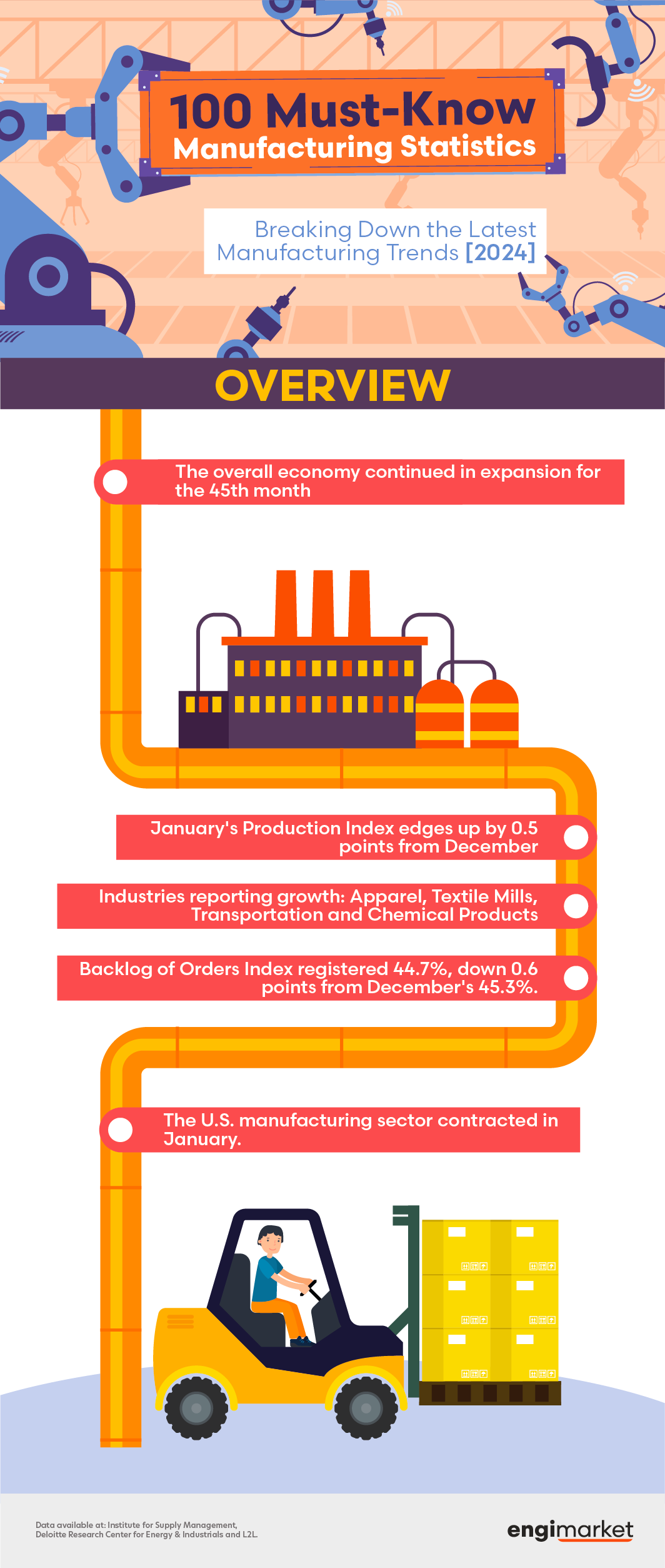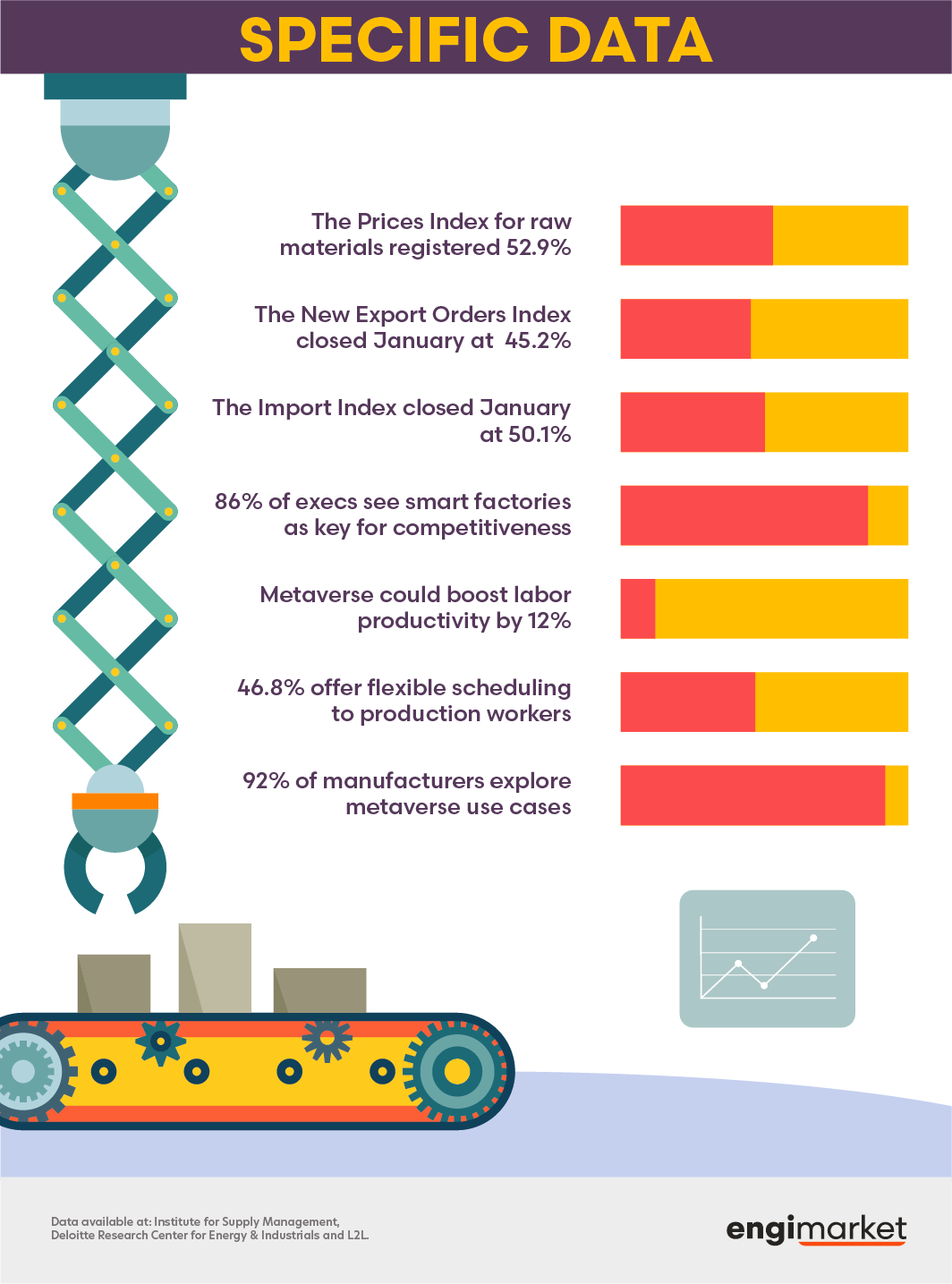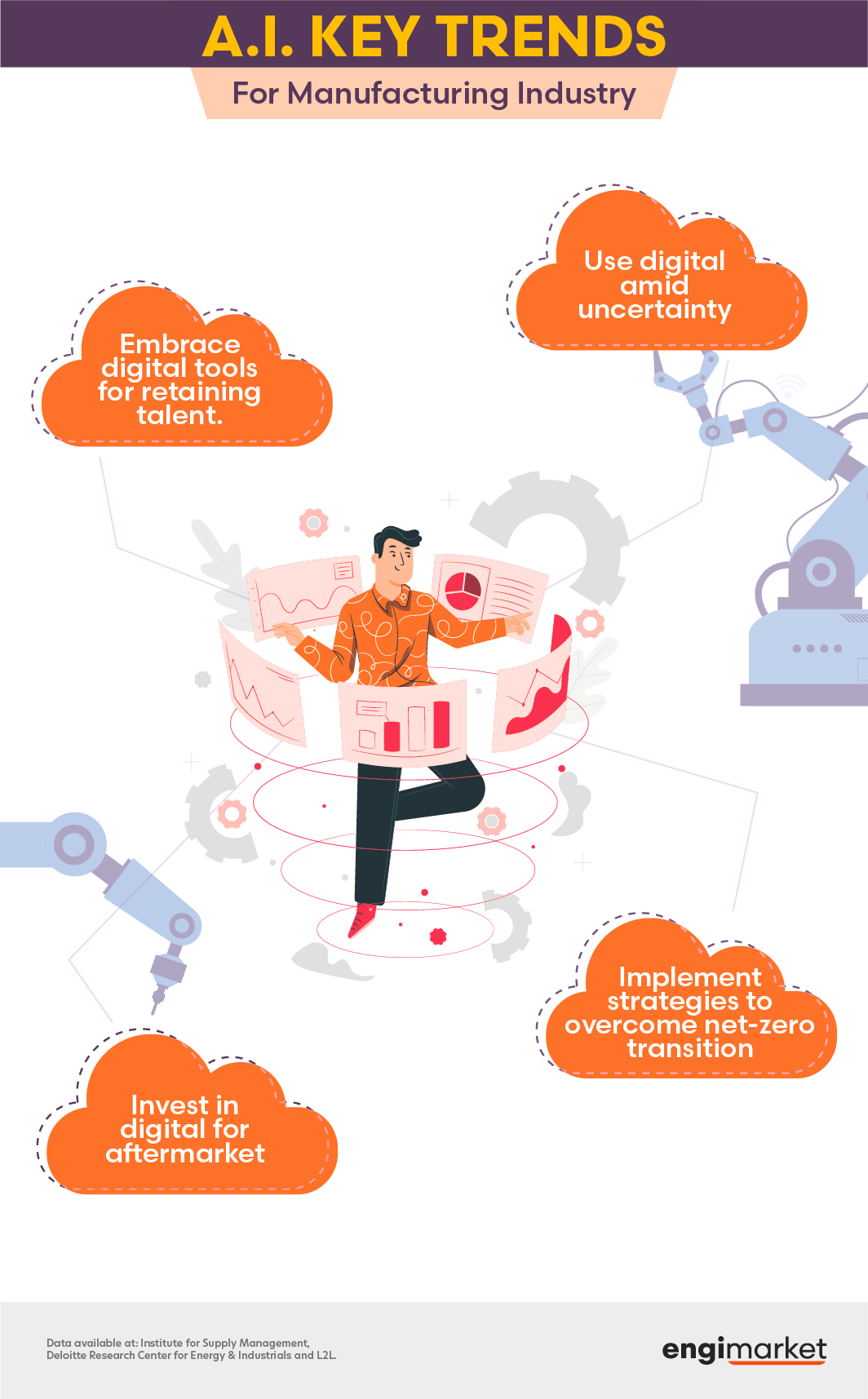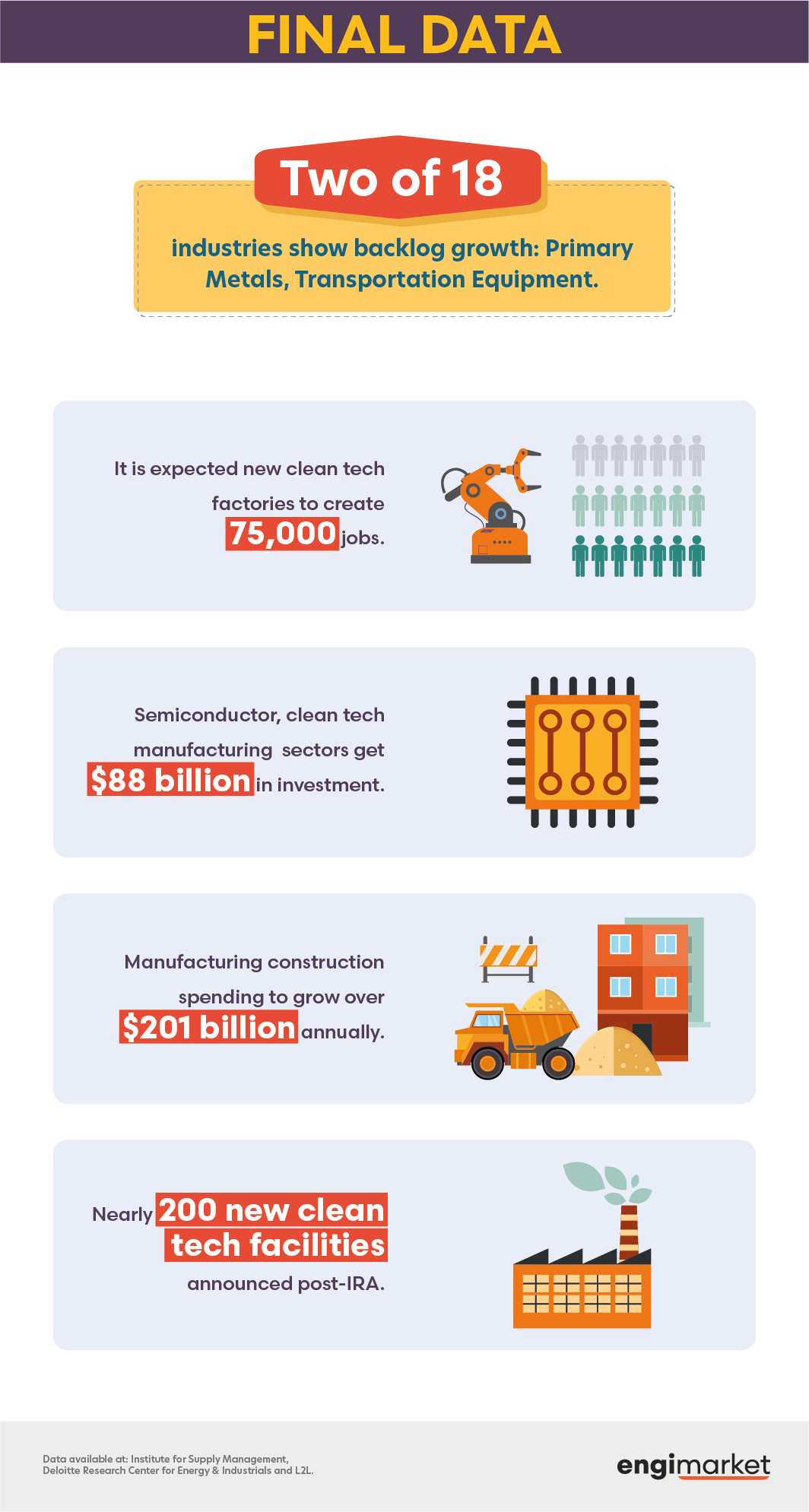![100 Must-Know Manufacturing Statistics [2024] 100 Must-Know Manufacturing Statistics [2024]](https://www.engimarket.com/wp-content/uploads/2024/03/manufacturing-industry-data-statistics-6.png)
In the intricate tapestry of economic indicators, the latest insights into the manufacturing sector paint a picture of both continuity and flux. According to the nation’s supply executives, January marked the 15th consecutive month of contraction in economic activity within manufacturing, following a brief hiatus denoted by a month of ‘unchanged’ status.
This downturn stands in stark contrast to the preceding 28 months of growth. However, amidst this overarching trend, nuances emerge, revealing pockets of resilience and potential for recovery. Let’s delve into the numbers to decipher the intricate dynamics at play.
Overview
1. Economic activity in the manufacturing sector contracted in January for the 15th consecutive month. [ISM]
2. The overall economy continued in expansion for the 45th month after one month of contraction in April 2020. [ISM]
3. The New Orders Index moved into expansion territory at 52.5%, 5.5 percentage points higher than the seasonally adjusted figure of 47% recorded in December. [ISM]
4. The January reading of the Production Index (50.4%) is 0.5 percentage point higher than December’s seasonally adjusted figure of 49.9%. [ISM]
5. The Prices Index registered 52.9%, up 7.7 percentage points compared to the reading of 45.2% in December. [ISM]
6. Backlog of Orders Index registered 44.7%, 0.6 percentage point lower than the 45.3% recorded in December. [ISM]
7. The Employment Index registered 47.1%, down 0.4 percentage point from December’s seasonally adjusted figure of 47.5%. [ISM]
8. The four manufacturing industries reporting growth in January are: Apparel, Leather & Allied Products; Textile Mills; Transportation Equipment; and Chemical Products. [ISM]
9. The U.S. manufacturing sector contracted in January. [ISM]

Specific Data
10. Fabricated Metal Products and Plastics & Rubber Products are the two industries reporting customers’ inventories as too high in January. [ISM]
11. The Prices Index for raw materials registered 52.9%. [ISM]
12. The two of 18 manufacturing industries that are reporting growth in order backlogs in January are: Primary Metals and Transportation Equipment. [ISM]
13. The New Export Orders Index experienced a decline and closed January at a value of 45.2%. [ISM]
14. The Import Index saw a slight increase compared to the previous year and closed January at 50.1%. [ISM]
15. The semiconductor and clean technology manufacturing sectors received a total of US$88 billion in investment. [Deloitte Research Center]
16. Since passage of the IRA, close to 200 new clean technology manufacturing facilities have been announced. [Deloitte Research Center]
17. It is expected new clean technology manufacturing facilities to create 75,000 new jobs. [Deloitte [Deloitte Research Center]
18. Annual construction spending in manufacturing is expected to grow more than US$201 billion. [Deloitte Research Center]
19. The manufacturing industry continues to face headwinds. [Deloitte Research Center]
20. In 2024, manufacturers are expected to face economic uncertainty. [Deloitte Research Center]
21. Purchasing Managers’ Index (PMI) data reveals that the manufacturing sector was in contraction for most of 2023. [Deloitte Research Center]
22. Technology is poised to play a significant role in supporting manufacturers in taking on the challenges they may face in 2024. [Deloitte Research Center]
23. Digital transformation will guide many manufacturers. [Deloitte Research Center]
24. Companies seem to be embracing the industrial metaverse. [Deloitte Research Center]
25. Generative AI is considered to be a relevant tool to add value to companies’ operations. [Deloitte Research Center]
26. 86% of surveyed manufacturing executives believe that smart factory solutions will be the primary drivers of competitiveness in the next five years. [Deloitte Research Center]
27. The industrial metaverse could lead to a 12% gain in labor productivity. [Deloitte Research Center]
28. Generative AI is expected to hold immense potential in areas such as product design, aftermarket services, and supply chain management. [Deloitte Research Center]

AI Key Trends For Manufacturing Industry
29. Manufacturers can consider employing new digital tools in order to improve talent attraction and retention. [Deloitte Research Center]
30. Manufacturers are increasingly leveraging digital technologies to face of economic uncertainty. [Deloitte Research Center]
31. Supply chain challenges persist, and manufacturers are pivoting toward digital solutions to drive supply chain efficiency. [Deloitte Research Center]
32. Manufacturers are investing in digital technologies that can create new and enhanced aftermarket. [Deloitte Research Center]
33. Manufacturers are implementing a variety of strategies to overcome some of in product electrification and decarbonization challenges associated with the net-zero future transition. [Deloitte Research Center]

Talent Obstacles
34. 46.8% of surveyed manufacturing executives pointed out that their company offers flexible scheduling to production workers. [Deloitte Research Center]
35. Many manufacturers face challenges in acquiring the right talent to meet current and future demand. [Deloitte Research Center]
36. Companies are investigating the use of digital tools, such as artificial intelligence, to quantify the need for employees in both new and established manufacturing facilities. [Deloitte Research Center]
37. Digital solutions have also been employed to help improve access to temporary labor. [Deloitte Research Center]
38. Some manufacturers have expanded their talent pool by partnering with organizations using innovative mobile applications powered by AI for engaging and screening potential employees. [Deloitte Research Center]
39. Establishing alumni programs for retired employees could be an effective strategy for sustaining engagement. [Deloitte Research Center]
40. Knowledge networks could help retirees stay connected to company activities, aiding in potential job opportunities and knowledge transfer to younger workers. [Deloitte Research Center]
41. Collaborating with early STEM educational programs can help manufacturers nurture local talent, mentor students, and build future STEM-ready workforce pipelines, benefiting community involvement and long-term talent attraction and retention. [Deloitte Research Center]
42. Manufacturers should also consider methods to generate fresh opportunities for upskilling their current workforce. [Deloitte Research Center]
43. Companies could allocate three extra hours daily per person through digitization and automation, using this time for additional training sessions. [Deloitte Research Center]
44. This approach helps prepare employees for current and future roles, including those demanding advanced digital skills, and supports career progression. [Deloitte Research Center]
45. The industrial metaverse can be employed to offer new, efficient, enhanced, and flexible training methods that can be accessed even from remote locations. [Deloitte Research Center]
46. 83% of manufacturers believe that smart factory solutions will transform the way products are made in five years. [Deloitte Research Center]
47. Smart factories offer extensive benefits, including enhanced asset efficiency, labor productivity, and product quality, leading to significant cost reduction and advancements in safety and sustainability. [Deloitte Research Center]
48. Over 70% of surveyed manufacturers have woven technologies such as data analytics and cloud computing into their processes. [Deloitte Research Center]
49. Nearly half of the smart factories are already harnessing the power of IoT sensors. [Deloitte Research Center]
50. 92% of surveyed manufacturers are already experimenting with or implementing at least one metaverse-related use case. [Deloitte Research Center]
51. 76% of manufacturers are adopting digital tools to gain enhanced transparency into their supply chain. [Deloitte Research Center]
52. Approximately one-quarter of surveyed manufacturers intend to implement these technologies within the next year, suggesting the possibility of a new wave of adoption and innovation. [Deloitte Research Center]
53. Aftermarket services have increasingly become a valuable tool for manufacturers. [Deloitte Research Center]
54. Aftermarket services can create consistent revenue flows and offer 2.5 times greater operating margins than new equipment sales. [Deloitte Research Center]
55. Manufacturers are starting to move beyond annual maintenance contracts. [Deloitte Research Center]
56. Aftermarket allows manufacturers to work more closely with their customers. [Deloitte Research Center]
57. Having a robust aftermarket presence is likely to provide a competitive advantage for manufacturers. [Deloitte Research Center]
58. Over 125 new manufacturing facilities for clean vehicle and battery technology production have been announced in the United States since the IRA was signed into law in August 2022. [Deloitte Research Center]
59. As companies transition towards electrifying and decarbonizing their product portfolios, they encounter various challenges such as: technical readiness, high initial costs, complex supply chains for batteries and rare earth metals. [Deloitte Research Center]
60. Leading engine manufacturer is investing over US$1 billion in its US facilities to support engines that run on low-carbon fuels such as hydrogen. [Deloitte Research Center]
61. Manufacturers are committed to creating zero-emissions products and technologies, including modular and scalable advanced power sources and electrified drivetrain product lines, to help customers achieve their climate-related goals. [Deloitte Research Center]
62. Some manufacturers are targeting adjacent markets to align with electrification trends. [Deloitte Research Center]
63. Significant investment and growth in the US manufacturing industry is expected to continue in 2024. [Deloitte Research Center]
64. Manufacturing companies are increasing their investment in data management solutions. [LNS]
65. It is expected that companies expand their data collection and governance processes.[LNS]
66. By efficiently managing data across their organizations, manufacturers can gain insights and improve decision-making. [LNS]
67. Cobots are a subset of robotics designed to work alongside people in industrial settings. [LNS]
68. The global cobot market is expected to reach almost $2 billion (USD) in 2026. [LNS]
69. Manufacturers are beginning to embrace the product-as-a-service (PaaS) model. [LNS]
70. The PaaS model can help companies meet the rising demand for flexible, cost-effective solutions, fostering innovation while promoting resource efficiency and waste reduction. [LNS]
71. Manufacturers are boosting their investments in resource-efficient production processes in 2024 and beyond. [LNS]
72. In 2024, we anticipate seeing more plants integrating robotics, AI, sustainable packaging, and recycling initiatives into their production processes. [LNS]
73. In 2024 and beyond, manufacturers must focus on future-proofing their businesses. [LNS]
74. The rapid progress in technology is at the core of IX, opening up ways for innovative solutions and opportunities in the industrial sector. [LNS]
75. Adapting to evolving market dynamics is increasingly essential, requiring transformation to sustain and improve competitive advantage. [LNS]
76. The modern consumer demands personalization, quality, and convenience. [LNS]
77. Industries are evolving to meet changing expectations, moving towards a customer-centric model. [LNS]
78. Sustainable and responsible manufacturing is receiving increasing attention. [LNS]
79. IX provides the tools and methodologies for achieving greener, more sustainable industrial practices. [LNS]
80. Global governments are enacting policies to promote smarter, safer, and more sustainable industry practices, driving transformation. [LNS]
81. Industrial transformation is a lengthy process that demands foresight, commitment, and continuous collaboration, often extending beyond a year. [LNS]
82. The duration of IX journeys varies significantly among companies, influenced primarily by their digital maturity level. [LNS]
83. Most industrial enterprises will require three to five years to complete a transformation process properly. [LNS]
84. The speed at which industrial enterprises go from vision to value depends on your organization’s preparedness for IX. [LNS]
85. IX is complex and time-consuming, impacting all business areas, necessitating a staged journey. [LNS]
86. Like all significant technological (and cultural) shifts, industrial transformation journeys present various challenges. [LNS]
Industrial Transformations Fail
87. Some experts report that up to 70% of transformations end up failing. [LNS]
88. Without full support from organizational leadership, securing time, resources, and backing for a successful technological overhaul in IX initiatives is challenging. [LNS]
89. If top management lacks support for IX, employees are unlikely to embrace it. [LNS]
90. For IX success, a clear vision, strategy, and stakeholder alignment are vital. A detailed, multi-phase plan for implementation, optimization, and continuous improvement is essential. [LNS]
91. Although upgrading your current tech stack might appear burdensome, it’s much simpler and more cost-effective than uncovering system inadequacies during the middle of an IX. [LNS]
92. Change brings disruption, and not everyone embraces learning new tools and systems. Therefore, clear communication of the value of IX to all affected parties is crucial. [LNS]
93. IX initiatives frequently fail due to workforces lacking the skills and training to fully leverage the value of new technologies. [LNS]
94. Implement solutions such as a connected worker platform to ease the learning curve. [LNS]
95. Inadequate project management and leadership can result in goal misalignment, inefficient resource allocation, and lack of direction, hindering the successful execution of IX initiatives. [LNS]
96. Make sure you have both market planning and research before committing to your IX journey. [LNS]
97. Once you completed your IX journey, it’s time to assess your organization’s readiness for an endeavor of this scale. [LNS]
98. When handled the right way, IX brings indispensable benefits to manufacturing facilities. [LNS]
99. IX can increase productivity and efficiency, reduce downtime, and enhance workforce longevity. [LNS]
100. Remember: every IX success story begins with an organization that’s fully prepared. [LNS]


![100 Must-Know Manufacturing Statistics [2024]](https://www.engimarket.com/wp-content/uploads/thumbs_dir/woodworking-small-business-outlook-us-2024-statistics-2-qpvarof27v5mm3dmvof1nnl7di1hph5ruo1otg820s.jpg)
